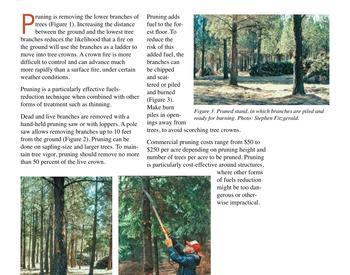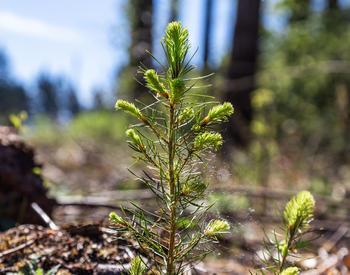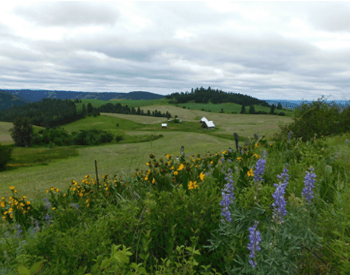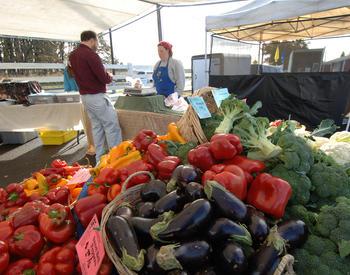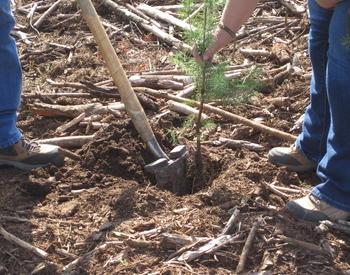Transcript
From the Oregon State University's Extension Service you are listening to In The Woods with the forestry and natural resources program. This podcast aims to share the voices of researchers, land managers, and members of the public interested in telling the story of how woodlands provide more than just trees they provide interconnectedness that is essential to your daily life. Stick around to discover a new topic related to forests on each episode. I'm your host Carrie Berger, fire program manager to the new Extension Fire Program. Today's podcast is about well us forestry and natural resource Extension. I'm joined by members of the forestry natural resource Extension team who are also the producers of the show. Together we have over 70 years of extension experience. Let's kick it off with my colleague Stephen Fitzgerald. Steve is an Extension silviculture specialist and the director of the college of forestry research forest. Steve I put this out in a good way that you've been with extension for a long long long time.
Stephen: Yeah that's right I have a little bit of history um I have 37 years of experience working in Oregon's east and west side forests.
Carrie: Great, then tell us what exactly is forestry natural resource extension?
Stephen: Well i have to go back and start with a little history. In 1862 land grant colleges were created by president Lincoln under the Morrell act. The purpose of a land-grant college or institution was to bring education to the people of Oregon mostly in teaching, research, agriculture, and military methods. The federal government provided land that was then sold to create an endowment to support the growth of the new college which today is Oregon State University. The outreach mission of land-grant universities was further expanded by the Smith Lever Act of 1914 which created funding to establish cooperative Extension programs utilizing the land-grant university system throughout the united states. The purpose of the Extension service was to really extend information and new research findings from the university out to the people who could apply it directly on the ground or in their daily lives. The forestry and natural resources Extension program provides outreach using place based extension agents and state specialists to forest owners, ranchers, mills, state and federal agency managers, and to the public in the form of classes and seminars, field tours and demonstrations, publications, video, and applied research on a whole host of natural resource topics. We help with the how-to of managing your land.
Carrie: So Steve, what's with your title? It sounds a little bit complicated. First off, what is silviculture?
Stephen: Um yeah Carrie, I'm the statewide extension silviculture specialist and silviculture is the art and science of influencing the establishment and growth, composition, health, and quality of forests to meet diverse needs and values of landowners, societies, and cultures.
Carrie: Okay then Steve what does it mean to be an extension specialist?
Stephen: Well first off it means I get to work with a lot of different forest owners, foresters, and state and federal agency land managers, and it's really great! I work with extension agents to provide presentations, seminars, and field workshops on managing forests to meet landowner objectives and these topics could include anything from reforestation, thinning and density management, silviculture systems, managing for healthy and resilient forests. I also conduct applied research the findings which I incorporate into a lot of my workshops.
Carrie: I see very cool so well now I'm really curious about these people you call agents and I'm in luck because with us today we have Jacob Putney. Jacob is the extension agent in Baker and Grant Counties. Jacob can you tell us what you do as a county agent?
Jacob: yeah Carrie, so I'm one of 10 agents across Oregon and much like Steve I get to work with a lot of different forest owners, foresters, state and federal land managers, but my work is more focused within the communities I serve which are in Baker and Grant Counties. Uh as an agent it's my responsibility to provide objective research-based educational opportunities related to forestry and natural resources, but particularly small woodland management. To accomplish this I'll host workshops and field tours of my own, but I'll also invite other partners to provide their own perspectives and expertise. In addition I work closely with specialists and the coordinators of the various programs we have within forestry natural resource extension and help offer these programs within the counties I serve. When I'm not teaching any classes or workshops, I serve as a point of contact for community members who have questions about a variety of forest topics such as sick trees, forest ecology, forest management, and things like fire risk reduction. Landowners will regularly invite me out to their woodlands to either show me an interesting project they've been working on or to ask my opinion about a problem they're having. I guess to sum it up I get to wear a lot of different hats and interact and collaborate with a variety of different folks in the forestry and natural resource realm. I really never know what my next question or my next challenge is going to be so being an agent really keeps me on my toes. But, it is rewarding to be able to address the specific needs of the community and help the best that I can.
Carrie: I bet you must really understand the needs of the people when you work and live in the same community. So I'm intrigued about the programs Jacob mentioned and I'm wondering if Jason O'Brien, the coordinator for the Oregon Master Naturalist program can tell us a little more?
Jason: Yeah thanks Carrie. Forestry and natural resources extension is a very diverse set of programs we offer to Oregonians. There's not really enough time to get into much detail on each of them, but I thought I would highlight four that I think reflect the breadth of focus areas that are taught by our team. There's obviously the focus on forestry, and the master woodland manager program attracts small woodland owners from around the state who want to know how to manage their woods and share the knowledge they gain in this intensive forest management training with people in their local communities. It has been doing this for over 25 years serving more than 500 land owners from around the state. The newest program not even a year old is one you're very familiar with Carrie, the fire program. Its purpose is to assist in identifying landscapes with the highest need for intervention to reduce wildfire and landscape health risks. It will help implement projects on the ground in these priority landscapes and provide education and outreach for all Oregonians throughout this process. They will do this with the help of our newest team members, regional fire specialists. As has been hinted at woodlands and forests are more than just trees and two programs epitomize a broader focus on natural resources. The Oregon natural resources education program or ONREP has its roots starting in the 1970's. It offers professional development trainings to classroom teachers and other educators throughout Oregon. Educators learn through hands-on trainings how to meet state and national learning standards while engaging students in nature-based learning that promotes the development of critical thinking and creative problem solving needed for life and work in the 21st century. It's truly a program for the future of Oregon's forests and other natural resources. Finally, the Oregon master naturalist program, started in 2009, is the program I coordinate and the other master volunteer program offered by forestry and natural resources extension. But, unlike the master woodland manager program, participants in this program come from all kinds of backgrounds not just forest land owners. What they all have in common though is an interest in Oregon's natural history, ecology, geology, and diverse landscapes that living organisms and we humans call home. Graduates of this program have thus far contributed nearly 70,000 hours of service for local, state, and federal natural resources agencies and a diversity of non-profit organizations. Listeners can visit our podcast website for a link to forestry and natural resources extension. Where they can learn about our many other programs I didn't cover. Whatever their area of interest or learning needs, Carrie, they will find a program worth their time.
Carrie: Thanks Jason, so what I'm hearing is that extension has over a hundred year history of serving its community members. Agents and specialists serve Oregonians in nearly every county and offer programming based on their needs. So, why do a podcast? Lauren Grand, extension agent in Lane County will tell us about the goals of this podcast and what folks can expect to hear.
Lauren: Well Carrie, as extension faculty we want nothing more than to bring everyone outdoors and into the woods to explore all the nooks and crannies of forests and woodlands that make them such a unique and fascinating ecosystem. Since unfortunately that just isn't possible to bring everyone to the woods we wanted to find a way to bring the woods to them by sharing the stories and interviews of forest scientists, land managers, and enthusiastic members of the public. Each month we'll bring you research and science-based information on a new topic related to forests that aims to offer some insight into what we know and what we're still learning about forest science and management. The episodes will start off broad to introduce major topics such as fire and then subsequent episodes will dive into the nuances to help listeners gain a deeper understanding of those topics. For example, a subsequent episode on fire may look at how fire behaves differently in forests where fires are suppressed only, forests where mechanical management is done to reduce fuels, and forests where prescribed fire is used to mimic historic fire behavior. We already have over a year's worth of topics we're really excited to share with you including how forests grow, the role of forest soils, effects of climate change on forests, fungi the great decomposers, and so many more! No matter where you are in the world we hope to offer you experiences like turning into a salamander crawling through a rotten log looking for a tasty morsel or a moist place to lay your eggs. You won't want to miss an episode, but if you do you can find all our episodes and resources on our website it's at blogs.oregonstate.edu/inthewoodspodcast.
Carrie: Thanks Lauren! Okay group, I have to ask you, what is your favorite tree?
Stephen: Well Carrie, this is Steve, um mine would be western larch it's one of the most fire resistant trees we have, but the other interesting fact is that it is a conifer that actually loses its needles in the fall and produces a very bright yellow fall foliage.
Carrie: I love that foliage it's so beautiful what about you Jacob?
Jacob: That's a good one Steve especially this time of year when they're about to start changing colors. Uh I'll probably have to go with Douglas-fir then one of the most important and prevalent species here in the pacific northwest
Carrie: Awesome, Jason?
Jason: Yeah i would have to say the Oregon white oak. Um because it's a keystone species and it's been known to support some 200 other species of wildlife and uh this time of year you will often see acorn woodpeckers trying to find the perfect little hole in their granaries to fit the acorns for store uh to get them through the winter.
Carrie: and Lauren, what about you what's your favorite tree?
Lauren: Well Carrie, my favorite tree has got to be the sugar pine it was the first tree that got my feet wet in forestry and I did my research thesis on it.
Carrie: Excellent okay so then my final question for you all. What's your must-have favorite tool, so when you're out there walking in the woods? what do you have to have with you? Steve?
Stephen: I usually have an increment borer with me and an increment for you can use to to drill into the tree and to extract out a core to get the age of the tree by counting the rings, as well as, you can tell how vigorous or how healthy the tree was over time and so it tells a little story about that tree's life.
Carrie: very cool, Jacob?
Jacob: Well i don't really know if it's my favorite tool, but it is my must-have and that's my epi pen because I don't get along with yellow jackets very well.
Carrie: That's a good tool to have then, Jason?
Jason: Yeah luckily I'm not allergic to yellow jackets um I'd have to say maybe two favorite tools if you'll allow me, a good bird field guide and a pair of binoculars. I'm a birder so I can't go out in the field without those.
Carrie: All right, Lauren?
Lauren: well um, my favorite tool to bring in the woods is definitely toilet paper. So, in a pinch it's always you know useful for all the reasons why people originally think, but also because I often get the opportunity to teach landowners about measuring trees and toilet paper is actually a great way to mark out a plot and if you miss a piece it's decomposable so, um
a good tool to have, I think.
Carrie: There you go, but nobody said duct tape!
Lauren: maybe that'd be yours Carrie.
Carrie: thanks so much for being guests of the show today stay tuned for the next episode, What's In a Woodland?
Thanks so much for listening! Show notes with links mentioned on each episode are available on our website blogs.oregonstate.edu/inthewoodspodcast. We'd love to hear from you. Visit the tell us what you think tab on our website to leave us a comment, suggest a guest or topic, or ask a question that can be featured in a future episode, and also give us your feedback by filling out our survey. In the woods is produced by Lauren Grand, Carrie Berger, Jacob Putney, Stephen Fitzgerald, and Jason O'Brien who are all members of the Oregon State University Forestry and Natural Resources Extension team. This podcast is made possible by funding from the Oregon Forest Resources Institute. Music for In The Woods Podcast was composed by Jeffrey Hino and graphic design was created by Christina Friehauf. We hope you enjoyed the episode and we can't wait to talk to you again next month. Until then, what's in your woods?
you
In this episode, the team that developed the podcast discusses what OSU Extension Forestry is and what programs are offered. They also describe what to expect from future episodes.

